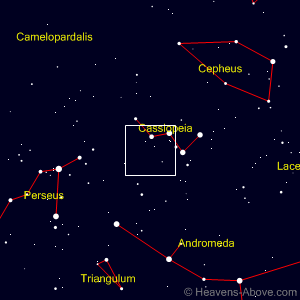
Finder chart showing Comet Lovejoy’s position on March 8, 2015. Courtesy of Heavens-Above.com
Comet Lovejoy (official designation, C/2014 Q2) is hanging around longer than anticipated but even so my last views of the comet seem sure to come sometime this week. I was out tonight viewing the comet, which has faded to around magnitude 6, and while I could spot it in 8×40 binoculars it took much more effort than it did two weeks ago.
Not only is the brightness fading but its position is becoming less favorable. Cassiopeia is sinking ever lower in the Northern sky putting the comet down in the proverbial atmospheric muck. What’s more is that my backyard isn’t ideal for observing in this direction. I have trees back there. Still, this is one instance where the switch to EDT actually helps, giving me an extra hour to get home and have a shot at observing the comet before it drops below the tree line.
I remember getting my first look at the comet in early January as it passed by Orion. It was an obvious sight in 16×50 binoculars and would’ve been easy to find in 8x40s. My log notes indicated it appeared “slightly larger than M42 but quite a bit dimmer.”
My best views of the comet came in late January and early February. The comet was very bright and some nights I could just make out its position by eye even from my suburban yard. Getting a telescope pointed at Lovejoy was easy during this period and I observed it through scopes ranging from 60mm to 10″, but most often in smaller telescopes, 80mm and under, at magnifications up to 40x. On a few occasions I even noted seeing hints of a wispy tail.
Even in its reduced state, Lovejoy is still worth viewing in a small telescope. Tonight it presented itself nicely in both the AWB OneSky 130mm and the FirstScope 76mm. In fact it was easier to find the comet in the FirstScope with a 25mm Plossl than it was in the 8×40 binoculars. Increasing the magnification to 30-40x still allows viewing of the pseudo-nucleus and coma.
Charts for the comet’s current position can be found at Heavens-Above.com.
-Dave
Original content copyright 2015 by David Philips. All Rights Reserved. This post may contain links to affiliate sites; sales through affiliate links may benefit this site.